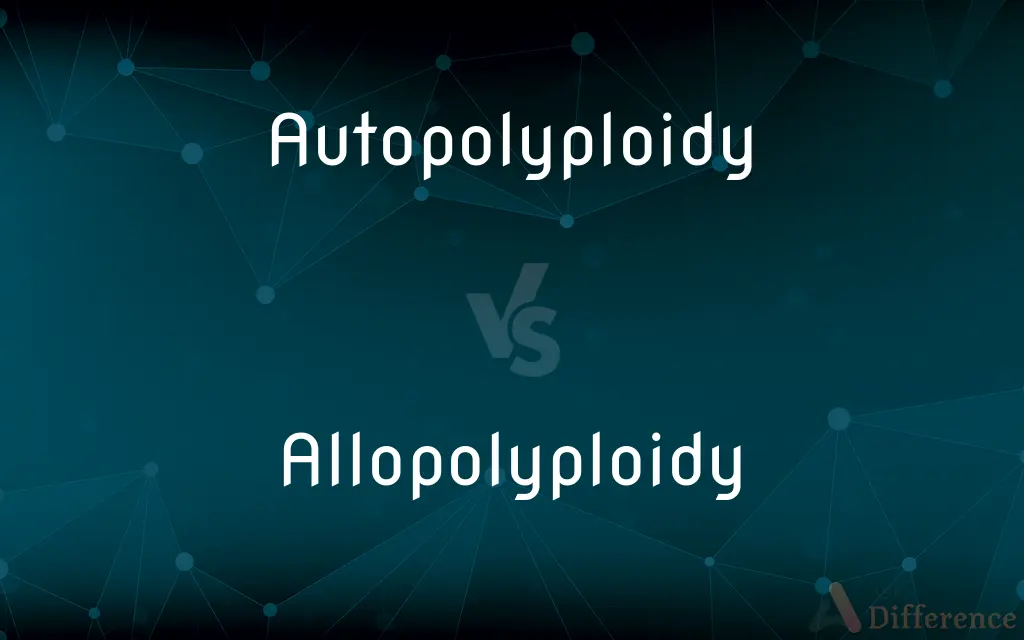Autopolyploidy vs. Allopolyploidy — What's the Difference?
By Fiza Rafique & Urooj Arif — Updated on March 21, 2024
Autopolyploidy involves chromosome duplication within a single species, while allopolyploidy results from hybridization between species, combining distinct sets of chromosomes.

Difference Between Autopolyploidy and Allopolyploidy
Table of Contents
ADVERTISEMENT
Key Differences
Autopolyploidy occurs when an organism has more than two sets of chromosomes, all originating from a single species. This can happen due to errors in cell division, leading to the duplication of the chromosome set. Allopolyploidy, conversely, involves the merging of chromosome sets from different species, typically through hybridization followed by chromosome doubling, resulting in a viable polyploid organism that often possesses characteristics of both parent species.
In autopolyploidy, the additional chromosome sets are identical, making it a form of polyploidy that enhances the genetic material without introducing genetic diversity from another species. This can lead to larger cell sizes and potentially larger plant organs, which might be beneficial in certain agricultural contexts. Allopolyploidy introduces genetic diversity by combining the genetic material of two distinct species, often leading to hybrid vigor and the ability to exploit new ecological niches or exhibit improved resistance to pests and diseases.
The process of autopolyploidy can sometimes result in reduced fertility due to the mismatching of homologous chromosomes during meiosis. However, allopolyploids may overcome this issue as they can form bivalents during meiosis, thanks to having two sets of homologous chromosomes, potentially leading to restored fertility in subsequent generations.
Autopolyploid organisms are often found in plants, where polyploidy can be a common phenomenon due to the less stringent requirements for chromosome pairing during reproduction compared to animals. Allopolyploid organisms are also predominantly found in plants, and they have played a significant role in the evolution and domestication of several crop species, offering a way to combine desirable traits from different species.
The study of both autopolyploidy and allopolyploidy is important in genetics, evolution, and agriculture, as these mechanisms of polyploidy contribute to biodiversity, speciation, and the development of crops with improved traits.
ADVERTISEMENT
Comparison Chart
Definition
Duplication of chromosomes from the same species.
Combination of chromosomes from different species.
Origin
Single species.
Two or more different species.
Chromosome Sets
Identical sets of chromosomes.
Distinct sets of chromosomes from each parent species.
Genetic Diversity
Limited, as all chromosomes come from one species.
Increased, combining genetic material of two species.
Fertility
Often reduced due to meiotic mismatches.
Potentially restored or enhanced due to bivalent formation.
Compare with Definitions
Autopolyploidy
Larger Cell Sizes.
Autopolyploidy can result in plants with larger cells and potentially larger features, like leaves.
Allopolyploidy
Genetic Diversity.
The genetic material in allopolyploids combines traits from two different species, increasing diversity.
Autopolyploidy
Agricultural Applications.
Some autopolyploid crops are cultivated for their larger fruit or flower sizes.
Allopolyploidy
Species Hybridization.
Allopolyploidy occurs when two different plant species crossbreed and their offspring's chromosomes double.
Autopolyploidy
Chromosome Duplication.
A plant species may develop extra sets of chromosomes due to errors in cell division, becoming autopolyploid.
Allopolyploidy
Hybrid Vigor.
Allopolyploid plants often exhibit hybrid vigor, with enhanced growth and resilience.
Autopolyploidy
Homogenous Genetic Material.
The genetic material in an autopolyploid organism is more uniform, originating from a single species.
Allopolyploidy
Restored Fertility.
Allopolyploids can have restored fertility due to effective chromosome pairing during meiosis.
Autopolyploidy
Having more than two sets of chromosomes in the cell nucleus all derived from the same species.
Allopolyploidy
Evolution and Speciation.
Allopolyploidy has played a significant role in the evolution of new plant species and varieties.
Autopolyploidy
An autopolyploid organism or cell.
Allopolyploidy
Having two or more complete sets of chromosomes in the cell nucleus derived from different species.
Autopolyploidy
The property of being autopolyploid.
Allopolyploidy
An allopolyploid organism or cell.
Allopolyploidy
(genetics) A form of polyploidy (having more than the usual number of chromosomes) that results from the interbreeding of different species.
Common Curiosities
What causes autopolyploidy?
Autopolyploidy is caused by errors in cell division that lead to chromosome duplication within a single species.
Can autopolyploidy affect animals?
While autopolyploidy is more common in plants, it can occur in animals but is usually less viable due to strict reproductive mechanisms.
Why is allopolyploidy important in agriculture?
Allopolyploidy can create crops with desirable traits from two species, such as increased resistance to diseases and pests.
Can polyploidy lead to new species?
Yes, both autopolyploidy and allopolyploidy can contribute to the formation of new species by creating genetic configurations that are reproductively isolated from the parent species.
Are all polyploid organisms fertile?
Polyploidy can lead to fertility issues, but many polyploid organisms, especially allopolyploids, can overcome these challenges over time.
What are some examples of allopolyploid crops?
Wheat, cotton, and canola are examples of crops that have allopolyploid origins, combining traits from different species for agricultural benefit.
How does allopolyploidy occur?
Allopolyploidy occurs through hybridization between two different species, followed by chromosome doubling in the hybrid.
How do autopolyploids and allopolyploids differ in meiosis?
Autopolyploids often face challenges with chromosome pairing during meiosis, while allopolyploids can form bivalents, potentially restoring fertility.
How does polyploidy contribute to genetic diversity?
Polyploidy increases genetic diversity by adding additional sets of chromosomes, in the case of autopolyploidy, or by combining genetic material from different species, in allopolyploidy.
Is polyploidy more common in certain environments?
Polyploidy is often more common in plants and can be particularly prevalent in environments where hybridization and rapid adaptation are advantageous.
Share Your Discovery

Previous Comparison
Advise vs. Counsel
Next Comparison
Admission vs. EnrolmentAuthor Spotlight
Written by
Fiza RafiqueFiza Rafique is a skilled content writer at AskDifference.com, where she meticulously refines and enhances written pieces. Drawing from her vast editorial expertise, Fiza ensures clarity, accuracy, and precision in every article. Passionate about language, she continually seeks to elevate the quality of content for readers worldwide.
Co-written by
Urooj ArifUrooj is a skilled content writer at Ask Difference, known for her exceptional ability to simplify complex topics into engaging and informative content. With a passion for research and a flair for clear, concise writing, she consistently delivers articles that resonate with our diverse audience.
















































